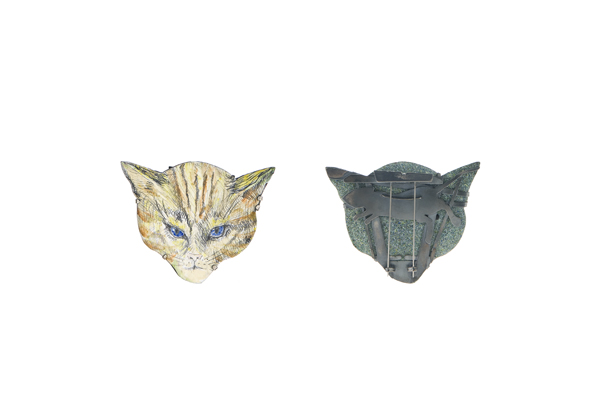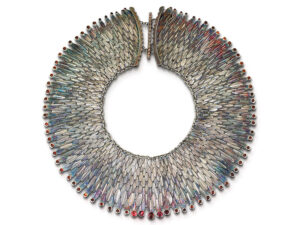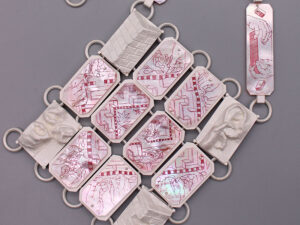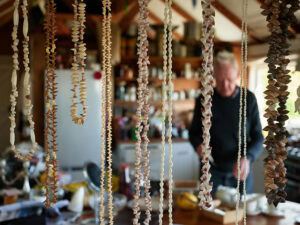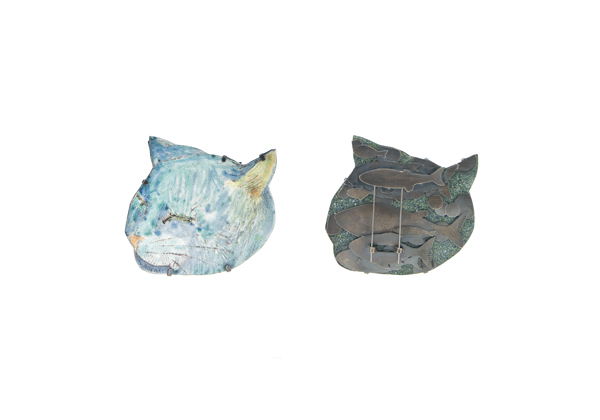
Susan Cummins: You were born in Berlin but you have traveled and studied in many other places. You are truly an international jeweler. Can you give us a travel guide to your education as a jeweler?
Tabea Reulecke: The idea of becoming a jewelry designer first raised its head while I was riding a dromedary on the island of Lanzarote. Born in East Germany, I was always wondering about the paradise behind the wall, so it might be no surprise that I really love traveling and discovering new places. My studies started at Idar-Oberstein, where I graduated in 2006. For an exchange I went to the Estonian Academy of Arts in Tallinn and to the Sandberg Instituut in Amsterdam. There was a very rich contrast at that time. After becoming the assistant in the department for gem and jewelry design here in Idar-Oberstein at the University of Applied Science, I got the chance, as a teacher, to visit many other universities and academies around Europe, and each of them has its specialties. In my own studio I continued to develop my works and took part in diverse national and international exhibitions. Sometimes I wonder about that day, when I was sitting on the dromedary and made a decision. What if it had been an elephant…?
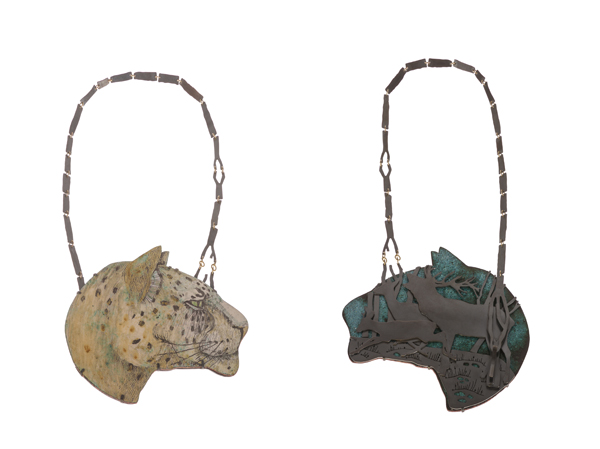
Tabea Reulecke: By their appearance, my works are not very influenced by my travels, but the way of creating has changed. As soon as I arrive at an airport, my steps get slower and I start to stroll. I enjoy that feeling. Everything has been done and I just need to wait, because I feel ready.
As a student and young artist I had the urge to realize all my ideas at once. I couldn’t be patient, and the fear of losing the feeling for making and finishing it pushed me forward. I believed that I could only create if the idea was fresh in my mind, ready to be born and materialized. Now I am much more relaxed. I take my time and realize those ideas that survive and stay in my mind. They have the potential and deserve their own time from the beginning to the end. In my studio I mostly start doing something without knowing the result: drawing, carving, playing with toys, and suddenly materials come together and start a symbiosis and grow further, supporting each other. During the process the idea can change because, for example, I don’t have the exact material that I first thought of, or because the technique didn’t work out. But I’m very flexible with accepting a change. I simply adapt the piece to the new situation and mostly discover something new. Detours are important; you never know who or what will cross your path.
You went to São Paulo, Brazil, for the opening of your show. How did it appear to you?
Tabea Reulecke: Thomas Cohn and his assistant welcomed me and took care of the exhibition setup. I love to work with young galleries. Fresh gallery owners put a lot of energy into their work and treat their artists very respectfully. Both sides are interested in success and push each other with trust and support. Thomas Cohn and I got in touch about two years ago, when he showed interest in my work at Galerie Marzee. He asked if I was interested in collaboration and offered to buy two of my biggest necklaces and offered a solo show in 2014. Contemporary art jewelry is very new in Brazil, but the people are interested and open to it.
São Paulo is a very crazy city, or shall I say a little country? It’s so big, and the chaos seems to grow without limits. As a German you grow up with many rules and safeguards. Even if I don’t see myself as a typical German, there in São Paulo I sure felt like one.
I met wonderful people from different art fields like fashion, photography, and sculpture. They were very interesting and it was a pleasure to share experiences.
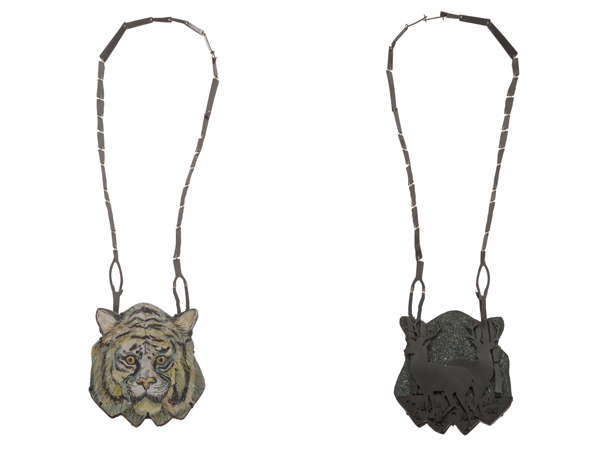
Tabea Reulecke: Animal interaction and communication fascinates me. The contrast of the predator and the prey is obvious in the collection. It is a fascination that started in my childhood. I had questioned, how I could be the Zodiac sign of Leo the lion and have the name Tabea, which means gazelle at the same time. Each of them has their own role. But the wearer has to make a choice. All the pieces are wearable from both sides.
Are you interested in mythology and story–telling related to animals?
Tabea Reulecke: Yes, sure. Why do these kind of stories exist? Look around.
I am surrounded by people who remind me of certain animals by their character, behaviors, and looks. On the other hand, people say their pet behaves like a human. Why not? You never know.
Your pieces are literally paintings and drawings on metal. By using enamel in this way, you enable your jewelry to carry narratives. You also include scenes on the back of the pieces as well. Do you make up stories for yourself about these leopards, tigers, and cats?
Tabea Reulecke: My greatest pleasure is telling a story to myself alone, and especially the climax shortly before the piece is finished. And then seeing the eyes of the one who reads the story anew, wears the jewelry, and creates something new.
On your website you say, “I am a maker of things.” Why not say “jeweler”? Do you make other things?
Tabea Reulecke: I don’t want to limit myself and my skills. I am a creator in my world and make many things. Some are known, some are not.
Where do you think the art jewelry field is going? What do you think about that direction?
Tabea Reulecke: Fourteen years ago I started with an internship in a traditional goldsmithery, and continued further on with metal design. For one year I learned all the basic skills and was able to realize my own first creations. When I began my studies in Idar-Oberstein, I had no idea of what art jewelry was—no idea of the possibilities you have and of how you could work in a “free” way. I discovered the immense variety of materials and that jewelry is a medium with so many variations. Everything was allowed. Only I could set the limits. Art jewelry is just a very small part in the big world of jewelry. There are so many definitions, like fine jewelry, design jewelry, conceptual jewelry, contemporary jewelry, handcraft jewelry…

I was lucky to get a job straight after graduation and had the time to continue with my own works. A monthly income ensured my process of making pieces that didn’t need to be commercial. I could continue to feel free in making without limitations and even without care about wearability, price, etc. In this way my works got attention and they were lucky to be a part of many exhibitions. During my travel I recognized which pieces I was wearing myself. And I noticed that they had to be wearable. These were earrings, which I made myself, a brooch of my great-grandmother’s for good luck, a medallion for protection from my mother, and a ring from my friend. When I forgot to put them on, I really missed them. I believed in their meaning and I was emotionally attached.
So, the big question appears again. What is art jewelry? Once I visited a small village in Thailand where I met a silk-making communities of old ladies. One of them won many prizes because her fabrics were always special, and I asked if she considered herself an artist. She looked surprised and addressed this question to her friend, who said that she always invented a new pattern in her fabrics, compared to the others, who stuck to the ordinary rules. I have seen much art jewelry and many pieces that don’t stick to traditional rules, but I still think as long it’s meant to be worn it should be wearable.
There are many jewelry makers in the world who all have their authority. I don’t want to judge the different fields, what is right or wrong, beautiful or ugly. As long as there are two sides, a maker and a receiver, everything is fine, I guess.
For me a big reason of making is joy. Making is describing the way of a process. Like traveling. But a ticket in your hands doesn’t ensure you will arrive, it only gives you a hint of future possibilities.
What have you read, seen, or heard recently?
Tabea Reulecke: The movie Who Cares?, a documentary about social interpreters by Mara Mourão.
Thank you.
